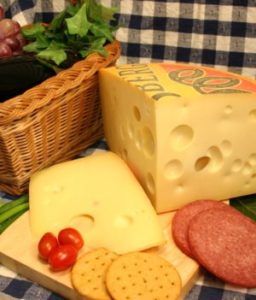Tag: Jarlsberg Cheese
Jarlsberg Cheese: Everything You Need to Know

What is Jarlsberg Cheese?
Jarlsberg cheese is from Norway and is known for its distinctive sweet and nutty taste. It has large, round holes and a very buttery texture. It is almost sweet whilst having a clean flavor.
It has become popular around the world, with huge sales in both the United States and the United Kingdom.
History of Jarlsberg Cheese
Cheese with holes has been made in Laurvig and Jarlsberg, in the south of Norway, since the 1830s. In 1956, Professor Ole M. Ystgaard from the Agricultural University of Norway began doing research on these cheese recipes, recognizing the value of this type of cheese. During his research he developed a semi-hard, medium-fat cheese with large holes, successfully combining the cheese-making traditions with modern technologies. The new cheese was named Jarlsberg Cheese after the county where the earlier version had been made.
The holes are the result of cheese cultures added according to a secret recipe that is closely guarded. The cultures will create carbon dioxide, making bubbles in the cheese that eventually leave holes.
How to eat it
This versatile cheese is great on a cheeseboard but can also be eaten in a variety of hot and cold dishes.
It’s truly awesome melted onto a burger, perfect for barbecue season. It makes an excellent fondue, ready for dipping in bread, apple slices, and celery sticks. Add it to Mac and Cheese for extra nutty, cheesy flavor. Try it in paninis with ham or mushrooms (or both!). It’s also a great cheese for grating onto any baked savory dish to add a cheesy topping.
For true simplicity, slice it thinly and make a sandwich with your favorite bread. This is one of the best ways to enjoy the flavor of the cheese without distractions.
What to drink with Jarlsberg®Cheese
To complement Jarlsberg Cheese’s sweet, nutty flavor and open texture, choose light, fresh white wines rather than reds. Dry or semi-dry whites made from Chardonnay or Riesling grapes are your best bets. Think Chablis, White Burgundy, or a light, spicy Gewürztraminer.
Jarlsberg Cheese also works well with most beers. For those with a taste for stronger drink, it combines perfectly with Aquavit, a traditional Scandinavian liquor distilled with aromatic botanicals like caraway, cumin, cardamom, orange peel, aniseed, and fennel. This creates an experience you won’t soon forget.
Imported Cheeses
Jarlsberg Cheese is one of our newer imports and we are proud to stock it. We have been adding to our selection and will continue to add more in the future. Some of our other imported cheeses include Canadian Cheddar, Chevre, Danish Bleu Cheese, Gouda, Gruyere, Manchego, Mozzarella, Parmesan, Provolone, Raclette, and Pecorino Romano.
Have you tried Jarlsberg Cheese? Let us know in the comments.
Jarlsberg: A Norwegian Experience And The Largest-Selling Imported Cheese In The US

Jarlsberg is often referred to as a type of Swiss or Baby Swiss cheese. It actually originated in Norway, but it’s a direct descendant of the great Swiss Emmentaler — the classic “Swiss” cheese with the large holes.
So, the story goes, Emmentaler cheese was introduced into Scandinavia around 1830, and within 20 years the Norwegians had adapted the recipe and were producing their own nutty, waxy, large-holed cheese in the county of Jarlsberg.
As the 20th century progressed, however, the holes started to disappear, even though the same manufacturing process was used. Food scientists finally figured out that the eyes and particular flavor of Emmental-style cheese were the result of a bacteria called propionibacterium, which was naturally present in the milk.
This particular bacteria eats away at lactic acid and produces carbon dioxide as the cheese ages, which forms the familiar air bubbles in the cheese. This would explain why neither Emmentaler nor Jarlsberg has a tangy taste.
As dairies began to be more concerned with sanitation and the milk began to undergo pasteurization, most of these bacteria were killed off, changing the nature of the cheese.
The modern version of Jarlsberg we find today was developed in the late 1950s at the Dairy Institute at the Agricultural University of Norway. This was a center of cheese research, and Jarlsberg was retooled to be a cross between Norwegian Gouda and Emmental, a smaller, softer, sweeter version of the Swiss mountain masterpiece.
The researchers began adding the propionibacterium back to the milk, selecting for a new strain that was compatible with the higher salt content of a Gouda.
Eventually they got it right, and Jarlsberg, by the pound, is the largest-selling imported cheese in the United States today. It is produced according to the very scientifically-controlled recipe in Norway, under license in Ohio (using the special bacterial culture shipped from Norway), and in Ireland by Diarygold.
Wheels of Jarlsberg cheeses are far smaller than Emmentaler, weighing about 22 pounds compared with Emmental’s 150-pound or larger wheels.
If you enjoy Jarlsberg, it is available online in light, 1-year aged, and smoked varieties.
Jarlsberg is available in most grocery cheese cases, is not terribly expensive, and is very suited to cooking. Anywhere you would use Swiss cheese, try Jarlsberg.
Jarlsberg-Potato Dippers
INGREDIENTS
1 Jarlsberg Lite cheese
1 cup instant potato flakes
½ teaspoon each black pepper and garlic powder
1 cup vegetable or chicken broth
DIRECTIONS
1) Preheat oven to 375°. Mix cheese with potato and seasonings; add broth and mix.
2) For lacy, crispy dippers, sprinkle mixture evenly on parchment-lined or (oil-sprayed) foil lining a 10×10-inch baking pan. Bake 25 minutes or until brown around the edges. Break into free-form pieces.
3) For a more solid, flexible dipper, spread mixture on parchment or foil, patting down for an even layer. Bake 35 minutes or until beginning to brown. Invert on wire rack, peel off parchment and return to pan to bake 10 minutes more. Cut into 2-inch squares. Serve with your favorite salsa. Makes 25 pieces.



